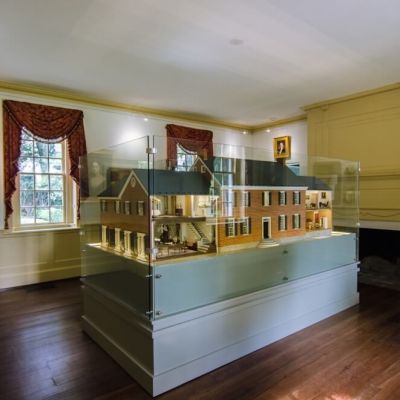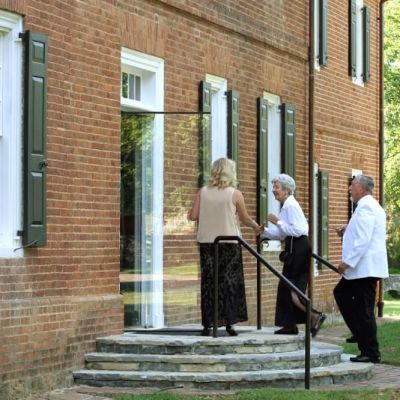GLEN BURNIE MANOR HOUSE
MUSEUM OF THE SHENANDOAH VALLEY
This project involves both the restoration and adaptive reuse of a house which had two different periods of significance—as a 1790’s farmhouse, and as a 1959 Colonial Revival estate.
The small, original brick farmhouse, built by Robert Wood in 1793, remains largely intact. The house was re-imagined in 1959 by Wood’s descendent, Julian Glass, and Glass’s partner, R. Lee Taylor, as a Colonial Revival country estate. At this time, Julian and Lee removed the non-original wings and porches and added new wings. The two men, who were romantically involved, created a lifestyle full of art, antiques, gardens, formal dining, and garden parties.
After the death of Julian Glass 1992, his house and gardens were opened to the public in 1997. The house was open for small house tours, for viewing the art, furniture, and antiques of the collection. However, since the house had not been updated since the 1959 renovations, it lacked climate control or any requirements for preserving the collection or accommodating the public.
A new museum was constructed on the Museum of the Shenandoah Valley property in 2005, to exhibit some of Glass’s collections, as well as artifacts and furniture representative of the craftsmanship of the Shenandoah Valley. After the Museum was built, the house continued to remain open for house tours. However, with lackluster attendance for the roped off tours, and the rapid decline of the economic viability of house museums in the United States, the non-profit group decided to change course. Consequentially, the house was re-imagined as an events building, to be used as a space for education, music, art, history, celebrations, and social functions. This transformation was done in the spirit of Julian and Lee’s entertaining lifestyle.
The project involved renovating and restoring the house to accommodate its new, assembly use on the first floor. Life safety and accessibility issues were paramount, but delayed maintenance issues were also addressed and corrected. The original section of the house was restored with minimal changes, while the more intrusive functional additions of restrooms, lifts, and a catering kitchen were inserted into the 1959 addition.
The first-floor diaphragm was reinforced. All new mechanical, electrical, and plumbing systems were installed, including a new, four-pipe HVAC system. Longstanding water problems were addressed. The old brick terraces had drained water towards the house; they were re-laid. The existing brick French drains, which allowed water to seep through the foundation walls, were retained for visual continuity, but new copper gutters and downspouts were installed. (The original gutters were removed by Julian during the 1959 construction project.) A new, accessible lift was installed into a 1959 era wet bar which was located under a staircase. Frameless glass doors were added to the front and back doors, which allows visitors a view to the formal gardens and allee of trees. A sunken terrace was reworked to accommodate larger numbers of people at parties, and new, oversized umbrella structures provide shade, without being permanently attached to the house. At the rear of the house, an inclined brick walkway was rebuilt to provide accessibility across the formal gardens and into the house.
The house now contains portions of the furniture, antiques, and art collection, as well as a detailed miniature of the house as it existed during Julian and Lee’s life together. The museum-quality furniture, art, and artifacts that were once in the house were moved to, and displayed in, the new Museum building. Non-museum quality artifacts were placed back into the house, to be sat on and used. Paint analysis was done, and all first floor rooms were restored to their original 1959 colors. With this latest renovation and restoration, the house now acknowledges, presents, and celebrates the lives of a gay couple in an honest and matter-of-fact way, which is a new approach for the Museum, and a relatively rare occurrence in museum circles.
PROJECT CREDITS
- Builder: Howard Shockey & Sons; Winchester, Virginia
- Structural Engineer: Painter- Lewis, P.L.C., Winchester, Virginia
- Mechanical Engineer Consultant: Comfort Design, Winchester, VA
- Architectural Historian: Maral S. Kalbian
- Preservation Historian. Berryville, Virginia
- Conservator & Paint Analyst: Susan L. Buck Ph.D. Newark, DE
- Dendrochronology Researcher: Dr. Daniel Miles, FSA – Oxfordshire UK
- Photography: Nathan Webb, AIA, LEED AP Reader & Swartz Architects / Rick Foster Photography Winchester, Virginia / Ron Blunt Photography
















